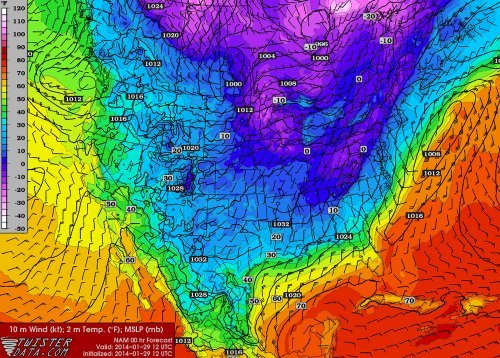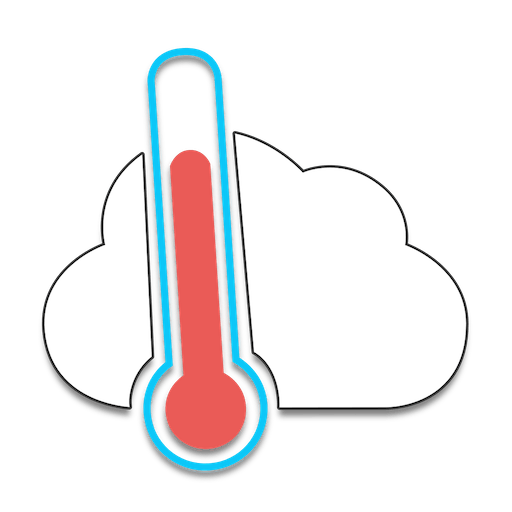Our wild weather will continue as another low pressure system tracking through the northern Prairies will bring with it mild temperatures and the probable risk for freezing rain over the Red River Valley, including Winnipeg.

Sounding for Winnipeg at 5:00PM local time. Note the significant AFL shaded in red.
Warm air will be pumped over the Red River Valley today as strong southerly winds develop ahead of a major low pressure system set to bring heavy snowfall to the northern reaches of Manitoba. 850mb temperatures will climb to nearly +5°C today, providing an ample AFL. The bulk of the precipitation with this system will be constrained to central and northern Manitoba, where anywhere from 5–20cm of snow are expected. Regions that were hit hard Monday will mostly be spared as the heaviest snow will fall further north than Monday’s system.
We’ll have breezy southerly winds in the Red River Valley today at around 40km/h with gusts to 60km/h with temperatures climbing all the way up towards –1°C by the late afternoon/early evening. As the warm front approaches the RRV in the late afternoon, it looks that an area of showers will blossom along it. There’s still some uncertainty in exactly where the precipitation will be and how quickly it will develop, but it looks probable that areas in the Red River Valley north of Morris will see freezing rain late this afternoon. Areas south of Morris have a very real chance as well, however there’s a little more uncertainty in how far south the band of showers will stretch.
We aren’t expecting huge amounts of freezing rain this afternoon; the quick-moving nature of this system will mean that even if the rain is intense, it’s likely that we’ll only 1–2mm of it. Keep in mind, though, that while 1–2mm isn’t a very significant amount for regular rainfall, it is a significant amount of freezing rain. It’s likely that the freezing rain will fall during the rush-hour period in Winnipeg and quickly turn roads into slick little skating rinks fairly quickly. If you drive to work, especially into or through the downtown core of Winnipeg, expect a slow commute this evening.
Skies will clear overnight as a weak cold front pushes across the RRV and Thursday will bring mainly sunny skies with temperatures falling through the day to –8°C by evening.. Winds will be breezy from the NW at about 30km/h before letting up in the afternoon. Another arctic ridge will push into Southern Manitoba, bringing another shot of cold weather with it. Temperatures will dip all the way to around –20°C on Thursday night and only recover to around –15°C on Friday.
Temperatures will level out a bit for the weekend with highs near –10°C for Saturday & Sunday, but it looks that a weak storm track will move over us, bringing cloudy skies and plenty of chances for light snow. We’ll have more on this weekend’s weather on Friday morning.
Northern Manitoba Communities Buried Under Massive Snowfall
An incredibly powerful low pressure system tracking through Northern Manitoba on Monday brought a nearly unprecedented snowfall event to many communities. Hardest hit were Norway House and Gods Lake Narrows where over 2 feet of snow fell. Environment Canada sent out a brief summary yesterday on the event:
A major winter storm moved across Central Manitoba on Monday, bringing with it some very heavy snowfalls. The heaviest band fell from the Norway House area east to the Ontario border, with numerous public reports of knee- to waist-deep snow accompanied by drifting as high as two metres. Lesser but still significant amounts were received by the surrounding regions of Gillam, Grand Rapids, and The Pas.
Unofficial snowfall totals are as follows:
| Location |
Snowfall |
| Norway House |
60–90 cm |
| Gods Lake Narrows |
60–90 cm |
| Island Lake |
60 cm |
| Oxford House |
45 cm |
| Cross Lake |
30–40 cm |
| Gillam |
35 cm |
| Grand rapids |
30 cm |
| The Pas |
30 cm |
| Mafeking |
23 cm |
While official snowfall records for northern Manitoba are hard to come by, it seems likely that these snowfalls are record-high snowfalls for a 24–36 hour period for Norway House, Gods Lake Narrows, and Island Lake. From what I could find, 1-day record-high snowfall totals in Northern Manitoba generally sit around the 40–50cm mark; these totals of 2–3 feet easily quash those records, and whether or not they end up as official “heaviest snowfall” records may come down to exactly how much fell in any given 24-hour period.

A visible composite satellite image from during Norway House/Island Lake snow storm.
The snowfall came from an extremely potent, moisture-laden low pressure system that managed to find the right combination of convective snowfall and duration. As shown in the satellite image above, a very strong moisture feed was evident as it surged northwards into the low pressure system rooted near The Pas. This system slowly tracked eastwards, producing heavy snow in the above localities for upwards of 18–24 hours.
A system like this is definitely an extremely uncommon one and is difficult to forecast due to the sparseness of surface observations and lack of RADAR imagery. It will likely be just now as this is published that some roads finally begin to be cleared and people are able to return to a more normal daily routine.
A further 5–10cm of snow is expected for the Norway House and Island Lake regions with the system passing through Manitoba today.






